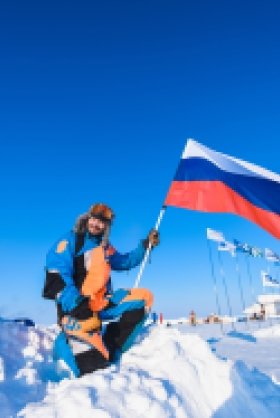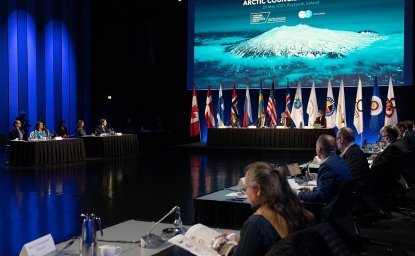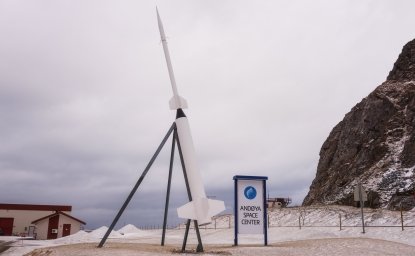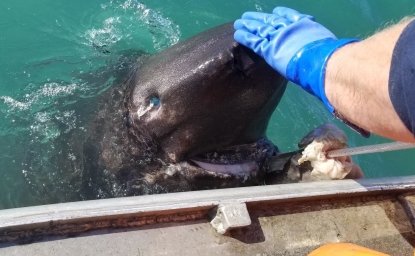
Introduction
The Arctic region presents a particularly interesting case study of Russian foreign policy. In a time when Russia is showing renewed aggression on three fronts – the Baltic Sea region, Syria, and Ukraine – and meddling in Western democratic processes, Russia’s behavior in the Arctic is so far largely cooperative. The question is: Why?
Russia’s behavior in this region is far from uniform. On the one hand, Russia planted a flag in 2007 on the far northern Arctic seabed during a scientific expedition to bolster their case for expansive polar sovereignty. On the other hand, Russia signed an agreement with Norway in 2010 to delineate maritime boundaries. Russia has increased its military activity in the Arctic, but is also adhering to binding agreements that enhance maritime safety and security.
As a result of Russia’s non-uniform behavior, Western assessments of Russia in the Arctic have led to polar opposite conclusions: Russia is a menacing military presence with expansionary designs; yet it is also a constructively engaged actor addressing neighborly concerns. This dichotomy in Russia’s foreign policy is not especially new. Throughout its history, Russia has simultaneously managed cooperation and competition with its neighbors and rivals. For example, during the Cold War, the Soviet Union sold oil and gas to Western Europe and bought Western goods, while maintaining the Warsaw Pact as a strategic buttress against NATO.
In examining Russia’s doctrine, discourse, and developments across the Arctic region, a picture emerges of Russia adopting different foreign policy behaviors depending on the context. Russia strives to maintain its competitive great power status in relation to the U.S. and NATO in the pan-Arctic.[1] At the same time, Russia is a cooperative member of the Arctic Council, as well as a regional partner alongside its northern European neighbors in the Barents Sea region.[2]
The reason for Russia’s simultaneous cooperative and competitive approach is that the Arctic is critical to Russia’s future economic growth and international standing. Estimates vary, but Russia’s High North is predicted to generate about 20 percent of its GDP and 22 percent of its exports. As Western Siberian hydrocarbons wane, Russia hopes to tap into the estimated 13 percent of the world’s oil, 30 percent of the world’s natural gas, and rare earth minerals located within in its Arctic zone. Russia anticipates a huge growth in the use of its maritime Northern Sea Route, connecting European and Asian markets and providing expanded opportunity to the approximately 2 million Russians residing near the Arctic coast.
However, Russia cannot sustain the development and potential use of its Arctic zone without the other Arctic states as partners. Russia requires investment, technology, know-how, and markets to ensure that its Arctic zone thrives. Russia’s strategy is therefore to balance its expansionist designs and military posture with constructive regional engagement in order to maximize the potential for economic growth in the Arctic.
What does Moscow Say about Russia’s Role in the Arctic?
Russian official doctrine recognizes the importance of the Arctic to its future and calls for both cooperation and competition. The energy strategies of 2003 and 2009 and the National Security Strategy of 2009 list Arctic natural resources as critical to Russia’s development. The two Russian Arctic strategy documents (2008 and 2013) focus on regional and international cooperation to meet national security interests. Starting in 2013, however, Russia names NATO as the primary national security threat in the Arctic, and declares countering that threat as a top priority. Russia’s Military Doctrine of 2014 and the subsequent Maritime Doctrine names the Arctic a strategic priority and the military as the protector of natural resources. Russia’s latest National Security Strategy envisions a global competition to secure and develop Arctic resources, while also identifying areas suitable for equal and mutually beneficial cooperation.
Russian political discourse features a debate over Arctic cooperation and competition. The more pragmatic line favors cooperation within the framework of international law. The more hardline view calls for Russia to adopt an offensive posture to protect its Arctic interests.[3] The hardliners adhere to a metanarrative that recalls the Red Arctic heyday of Soviet era industrialization and militarism.[4] At home, Russian leaders express the hope that tapping natural resources and opening a Northern Sea Route will enhance Russian power. Abroad, Russian diplomats insist that Russia is a regional Arctic player that is ready to cooperate through multilateral organizations.[5]
On balance, Russian foreign policy actors may distance themselves from any discourse on conflict and geopolitical competition, yet still oscillate between promoting international cooperation and declarations of expansive Russian sovereignty.[6] The foreign ministry focuses on socio-economic and environmental cooperation with Arctic states at the sub-regional level, especially in the Barents region. Russian presidential statements to domestic audiences promote Russia’s commitment to cooperation in the Arctic, except on the issue of those natural resources that, in Russia’s view, lie within Russia’s zone of economic control.
What do Russians do in the Arctic?
There are several geographically defined Arctic regions and organizations that make it difficult for Russia to stake out a clear role in the region. Instead, Russia has emphasized both its outsized role in the Arctic as proof of its great power status globally, while at the same time promoting cooperation regionally.
Russia must contend with several geographical groupings of Arctic sates. There is the North American contingent of the United States and Canada, both with sparsely populated Arctic territory, credible claims to energy deposits, and capable of deploying strategic forces. There is the Arctic Ocean 5 (the United States, Canada, Denmark/Greenland, Norway, and Russia). There is the Western 7 (NATO’s United States, Canada, Denmark, Iceland, and Norway; plus Finland and Sweden), who support strengthening a security community in response to Russia. There are the 4 Nordic countries bordering Russia, whose northern regions are the most densely populated and developed part of the Arctic. There is Russia’s vast Arctic zone, covering one-fifth of the Arctic Circle, and home to two-thirds of the world’s Arctic population, among them 27 indigenous groups. Finally, the Arctic as a “global commons” draws in non-Arctic states wanting a greater role in determining its development, among them China.
These geographical groupings have resulted in the creation, since the 1990s, of several multi-lateral organizations focused on the Arctic. In practice, the organizations do not address hard security issues, and instead foster through consensus cooperative efforts on softer security issues. The Arctic Council is the pan-Arctic organization that includes all 8 states (Western 7 and Russia), plus 6 indigenous organizations and over 30 non-Arctic observers. The Arctic Council meets at the national, parliamentary (including the EU parliament), and regional governmental levels. The Barents Euro-Arctic Council (BEAC) includes the 4 Nordic countries, the EU, Iceland and Russia. Related is the Barents Regional Council (BRC) that links up 13 local administrative and territorial entities in Russia, Norway, Finland, and Sweden, including Russia’s Karelia, Komi, Arkhangelsk, Murmansk, and Nenets regions. Other northern non-governmental regional organizations, such as the Nordic Council of Ministers and the Northern Dimension Environmental Partnership (NDEP) also promote regional cooperation.
The Arctic as a Means to Russia’s Greatness
Russia views its leadership role in the Arctic, both in unilateral and multilateral terms, as a means to sustaining its greatness. Russian doctrine and internal political discourse confirm this view. Russia has three major goals in the Arctic in support of fostering this status: to ensure Russia’s sovereignty over its exclusive economic zone and continental shelf in the region; to protect its economic interests in its Arctic zone; and to demonstrate that Russia possesses world-class military capabilities.[7]
Russia’s renewed territorial expansionism extends to the Arctic. Russia made a claim that its Continental Shelf under the Law of the Sea extended from its shore to the North Pole in 2001, a move followed by Norway and Denmark/Greenland. The latter’s overlaps with Russia’s. Russia wants to extend its 200 nautical miles of exclusive economic zone, within which it has sovereignty on the seabed and under the seafloor, to the furthest northern point. All these claims await a finding by the United Nations Commission on the Limits of the Continental Shelf, at which point a final settlement must be reached through negotiations among the claimants.
Russia is also striving to establish the primary Arctic seaway. Russia’s Northern Sea Route at present is the most viable route through Arctic waters, and climate change, ice cutters, and port enhancements will make it more accessible over time. The route will link Russia’s energy rich Arctic zone to the Atlantic and Pacific, potentially creating the third biggest energy corridor in the world. In the Arctic Council, Russia has prioritized maritime security, safety, and adherence to Polar Codes set by the International Maritime Organization. However, despite its overall promise, development plans for the Northern Sea Route have been slowed by unpredictable weather, depressed global oil demand, and Western sanctions limiting energy sector investment, finance, and technology sharing with Russia.
Russia’s military deployment strategy in the Arctic strengthens its nuclear deterrence and assists in its global military operations. Russia’s 2015 military doctrine describes how Russia will defend its northern flank with a combined land, air, nuclear, and maritime command structure. The Northern Fleet, Russia’s largest, is based in the Arctic with critical access to the Atlantic Ocean, and the fleet’s tactical nuclear weapons and strategic submarine capabilities bolster deterrence. Russia’s western Arctic zone also links the Baltic Sea to the Kola Peninsula, where prepositioned Russian forces are stationed to defend its northern flank from NATO.
The Arctic as a Means to Russian Regional Priorities
However, while the Arctic serves to bolster Russia’s greatness, Russia is not the dominant regional power, and it is not clear from Russian doctrine or discourse that it desires this role. In both the pan-Arctic and the Barents Sea region, all of the states are wealthy, highly developed, and not dependent on Russia for trade or security. There are EU members (Denmark, Finland Iceland, and Sweden) and NATO members (U.S. Canada, Denmark, Iceland, and Norway). Hence, Russia’s position is rather one of several regional powers engaged with different economic and security communities.
The Barents Sea region offers an interesting case study of the complexity of relations among states at multiple levels that involve both cooperation and competition. On the one hand, Russia demonstrates its military prowess by violating air and sea space, staging large scale exercises, reopening Soviet bases, and prepositioning forces. Russia also tests boundaries around Norway’s Svalbard archipelago and protests NATO activity it perceives as a threat. On the other hand, Russian officials consistently underscore the need to depoliticize cooperation in the region and keep channels of high-level communication open. Russia requires the support of Nordic countries for investment, finance, and technology to enhance its own energy production and regional development.
Representatives of the Barents region meet at every level, from civil society to sub-regional, regional, and state-level. They meet in governmental and non-governmental capacities. As the main regional organization, BEAC’s goals are to create a favorable environment for trade and investment, develop stable integration links, upgrade border and customs infrastructure, and create new transport routes. Russia has chaired the BEAC twice, most recently in 2015-2017, and prioritizes environmental issues and socio-economic development. Russia also chairs the Barents Regional Council. Typically, this province-level group is most concerned with people-to-people ties, promoting culture, and tourism.
These myriad and overlapping regional organizations have been generous in funding projects in Russia’s northwest Arctic region. Individual Nordic country financing (led by Norway), co-Russian financing with EU and participating countries, and leveraging monies from international financial institutions have enhanced the environment and economic development in Russia’s Arctic.
However, the imposition of international sanctions against Russia over the Ukraine crisis has slowed Barents regional cooperation down. Prior to the sanctions, Russia received funding for a variety of Barents projects from several European development and investment banks. However, after 2014, the bigger infrastructure projects have stopped or been postponed, and some smaller projects have failed to receive matching funds from the Russian government. Cooperation is further harmed by Russia’s recent labeling of various groups as foreign agents, including the Nordic Council of Ministers in St. Petersburg and several indigenous and environmental groups in Russia’s Barents region.
Nevertheless, Russia continues to demonstrate readiness to act in collaboration with other states. In the Arctic Council, Russia has recently led or co-led three task forces: One on marine oil pollution and prevention that led to a binding agreement; another on business that led to the establishment of the Arctic Economic Council; and a third on scientific cooperation with the U.S. that also led to a binding agreement. Importantly, all of these agreements will enhance Russia’s national interests by establishing Russia as an even more important regional player in the Arctic.
Factors Shaping Russia’s Role in the Arctic
While there is a recurring theme of simultaneous cooperation and competition at the pan-Arctic and regional levels, it is not clear from Russia’s doctrine, discourse, or practice that it has a clear idea of the ultimate role it wishes to play in the Arctic. Several factors continue to shape Russia’s role in the Arctic.
First, Russia’s actions in the Arctic have been neither linear nor static. Russian officials were more aggressive in the early 2000s, staking territorial claims and testing boundaries. This was followed by efforts to strengthen the capacity of the Russian government to act within international Arctic organizations and to pursue a more cooperative approach with its neighbors, concluding agreements with the U.S. and Norway that demarcated boundary lines as a result. After Putin returned to the presidency, the emphasis on security and military issues returned to the forefront. Today, there is a Kremlin-led effort to centralize its power over developments in its Arctic, in part to attract foreign investment and shore up domestic contributions from oil and gas companies to regional development to compensate for a limited federal budget and the impact of sanctions.
Second, the lack of clarity in Russia’s role in the Arctic is further affected by differing priorities among governmental agencies; between the center and peripheral governmental institutions in Russia; and between civil society and the regional governments. Debates can get heated between different Russian stakeholders and result in policy shifts. Environmentalists working on the Arctic are critical of energy and industry and demand more regulations and safeguards. Likewise, Russian legal experts have had to contend with the fisheries industry who protest boundaries negotiated by the Ministry of Foreign Affairs limiting their fishing zones. And indigenous groups continue to struggle to have their voices heard on issues of sustainable development where minerals and hydrocarbon production are prioritized.
Third, the trend line of potential confrontation challenges the strategy of cooperation. It is unclear if the zone of cooperation and peace in the Arctic, as envisioned by the Arctic Council, will remain. Already, sanctions on Russia related to the Ukraine crisis have halted some aspects of cooperation. Heightened military readiness prompted by elevated threat perceptions among all states has increased the chances of a conflict within the Arctic. In the Barents region, a decreased Russian budget for cooperation and the designation of certain cooperative groups as “foreign agents” have limited both the level and types of international contact.
Fourth, the pan-Arctic region is being reshaped by the slow, but gradual inclusion of extra-regional states with interests in developing natural resources in the Arctic. It is unclear how increased activity from non-Arctic states in the region may affect overall cooperation. Already, Chinese state owned companies financed the Yamal Nenets LNG terminal with Russia’s Novatek despite Western sanctions, made use of the Northern Sea Route, invested in mining in Greenland, and conducted oil and gas exploration offshore of Iceland. Increasing interest from other Asian states in Russia’s Arctic zone will affect both the pan-Arctic as well as Barents cooperation.
Conclusion: Balancing Cooperation and Competition
For now, the Russian government talks and acts very confidently about its ability to balance cooperation and competition in the Arctic. It is perhaps the only region left in the world where Russian and Western leaders meet on an equal level, promising to abide by international accords in demarcating boundaries, concluding binding agreements on softer security measures, and encouraging people-to-people contacts.
Arctic states should continue to encourage Russian constructive leadership in such areas as maritime safety and security, and scientific cooperation. Russia may ascend to a new maritime power status given its advantage in available ice cutters, Arctic ports, hydrocarbon development, and readiness to increase usage of the Northern Sea Route. We can expect to see Russia continue to pursue its interests in global organizations like the Arctic Council and the Barents regional organizations. How Russia (and other states) conduct themselves across this spectrum will be a key driver in Arctic developments.
At the same time, Russia’ competitive approach to securing more territory, resources, and Arctic military readiness could upset this delicate system of regional cooperation. There is the potential for the Arctic states to dispute territorial boundaries, particularly the North Pole and in the Barents Sea. Differences among Arctic states over strategic goals and visions elsewhere may also spill over into the Arctic, as the Ukraine crisis has shown. In this instance, Russia’s ability to balance cooperation and competition will become even more important.
[1] Mearsheimer, J. 2001. The Tragedy of Great Power Politics. W. W. Norton and Company.
[2] Fawcett, L. 2003. "The Evolving Architecture of Regionalization," in The United Nations and Regional Security ed. by Michael Pugh and Sidhu, 11-30.
[3] Konyshev, V. and A. Sergunin. 2014. Is Russia a revisionist military power in the Arctic? Defense and Security Analysis, 1-13.
[4] Laruelle, M. 2013. Russia’s Arctic Strategies and the Future of the Far North, M.E. Sharpe, Armonk, NY.
[5] Gritsenko, D., and Tynkkynen, V. P. 2016. Arktinen Venäjän poliittisessa viestinnässä. Idäntutkimus, 23, 3-18.
[6] Wilson Rowe, E. and Blakkisrud, H. 2014. “A New Kind of Arctic Power? Russia’s Policy Discourses and Diplomatic Practices in the Circumpolar North.” Geopolitics, 66-85.
[7] Ibid., Konyshev and Sergunin.
Author

National Intelligence University
Explore More
Browse Insights & Analysis
Fulbright Arctic Initiative IV Scholar at the Polar Institute

Trump 2.0’s Arctic Opportunity: Thawing Frozen Dialogue

